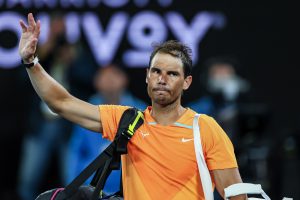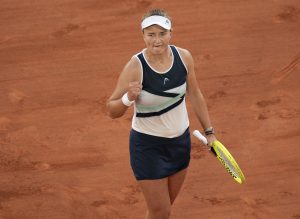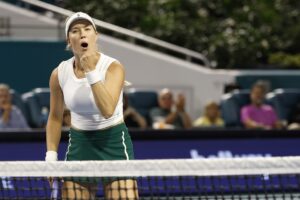Famous Five: with the ATP Finals starting this weekend, Martin Keady looks back at the finest finals in the tournament’s history.
The ATP Finals, as it is now called, has had many different names and many different formats over the near-half century that it has been in existence (2020 will be the 50th anniversary of the event). So, when it comes to considering the finest finals in its history, it is perhaps easiest just to think of them as the “End-of-Season Men’s Finals,” the last event (at least for those not involved in the Davis Cup final in December) before the season finally comes to a conclusion.
Here, then, are the five finest “End-of-Season Men’s Finals.”
- ANDY MURRAY BEATS NOVAK DJOKOVIC IN LONDON IN 2016 (6–3, 6–4)
Andy Murray has had such an awful 2017 that it is easy to forget how incredible his end to 2016 was, when he embarked on a three-month global odyssey to win every tournament he entered in order to overtake Novak Djokovic at the top of the men’s rankings. He actually achieved that lifelong goal by winning the Paris Masters, but if he was going to hang on to the top spot and finish as the year-end World No. 1, he had to extend his remarkable winning streak to the ATP Finals itself.
He did so by beating Djokovic himself in the final, in straight sets, after surviving a truly epic semi-final against Milos Raonic (winning tie-breaks in the second and third sets after narrowly losing the first set). Winning the event was the ultimate testament to Murray’s almost miraculous form at the end of a year in which he had already won both the Wimbledon and the Olympics men’s singles titles for a second time. Even the Queen, who is notoriously not a fan of tennis (having barely visited Wimbledon during her long reign), was sufficiently impressed to reward him with a knighthood, and whatever else “Sir Andy” achieves in the rest of his career, he will do well to regain the wondrous form he showed 12 months ago.
- DAVID NALBANDIAN BEATS ROGER FEDERER IN SHANGHAI IN 2005 (6–7, 6–7, 6–2, 6–1, 7–6)
The four other end-of-season finals on this list are all five-setters. The Masters, or ATP, or plain old End-of-Season Final was played over five sets until 2008, when the decision was made to switch from having five-set matches to three-set matches in the tournament, including for the final itself. Although having three-set matches undoubtedly makes some sense at the end of a long season, it also means that we will no longer see the genuinely epic End-of-Season Finals that only a five-set final can provide. And few, if any, of those five-set finals were as remarkable as the 2005 edition in Houston, when David Nalbandian came back from two sets down to beat Roger Federer.
The 2005 “Tennis Masters Cup” was the biggest prize that Nalbandian ever won, which is a shame given that he competed in both Major Singles Finals (Wimbledon in 2002) and Davis Cup Finals for Argentina. However, the fact that he could overcome the great Federer in five sets, even winning the final set in a tie-break after he had lost the first two sets in tie-breaks, serves as enduring proof of his enormous ability. It is for that ability that he should be remembered, rather than for his brainstorm at Queen’s in 2012, when he inadvertently hit a line-judge after lashing out at an advertising hoarding in frustration and was ejected from the tournament.
Embed from Getty Images
- LLEYTON HEWITT BEATS JUAN CARLOS FERRERO IN SHANGHAI IN 2002 (7–5, 7–5, 2–6, 2–6, 6–4)
For a few short years (two, in fact) at the start of the new millennium, at the end of the Pete Sampras era and the dawning of the Age of Federer, Lleyton Hewitt was the best male tennis player on the planet. He won the 2001 US Open by beating Sampras in straight sets and backed that up by winning Wimbledon the following year, beating the aforementioned David Nalbandian in the final, again in straight sets. And he ended 2002 in spectacular fashion, by winning a truly great End-of-Season final against Juan Carlos Ferrero.
2002 was the first year that Shanghai had staged the traditional End-of-Season tournament (it would stage it again from 2005 to 2008) and the final that Hewitt and Ferrero produced remains one of the finest ever seen in Asia. Hewitt eventually won through in five sets, but Ferrero, who had reached the French Open Final earlier that year and would go on to win Roland Garros the following year (to secure his only Major win), matched him all the way, fighting back from two sets down before losing, agonizingly, in the fifth.
The win enabled Hewitt to finish as the year-end World No.1 for the second year in a row. Almost immediately afterwards, Federer, Nadal, and then Djokovic began their domination of the men’s game and Hewitt would never be World No. 1 again. However, his triumph in Shanghai was a fitting way to bow out at the top, even if, at the time, he didn’t know he was doing so.
Embed from Getty Images
- PETE SAMPRAS BEATS BORIS BECKER IN HANOVER IN 1996 (3–6, 7–6, 7–6, 6–7, 6–4)
There is an argument that Pete Sampras became the player that Boris Becker had promised to be when the German won his first Wimbledon title in 1985, at the tender age of 17. Although Becker would go on to win five more Majors, including two more Wimbledons, he never quite achieved the dominance over the men’s game that he had initially threatened to. Instead, that dominance was achieved by Pete Sampras, who would win more than twice the number of Majors that Becker did (14 in total) and in the process prove himself to be probably the last great serve-volleyer in the history of tennis.
When Becker and Sampras met in Hanover at the end of 1996, the odds were against Becker, even though had “home court” advantage in Germany and was the defending champion. He had already lost a Wimbledon final to Sampras the previous year and in the middle of the 1990s Sampras was in his “imperial” phase as a player. Nevertheless, Becker showed all his old fighting spirit, reawakening memories of his spectacular emergence more than a decade earlier, as he fought Sampras all the way, only finally going down in five sets after one of the most amazing indoor finals tennis has ever seen.
Embed from Getty Images
- BORIS BECKER BEATS IVAN LENDL IN NEW YORK IN 1988 (5–7, 7–6, 3–6, 6–2, 7–6)
Fortunately for Boris, although he lost the second best End-of-Season Men’s Final, he won what is generally regarded as the best End-of-Season Men’s Final, when he beat Ivan Lendl in New York nearly thirty years ago. This was the Madison Square Garden era of the Masters or ATP Finals, when the greatest city on earth ended the tennis year by staging a series of memorable finals in front of massive audiences in the Big Apple.
Becker and Lendl played many great matches in the second half of the 1980s, but this End-of-Season Final was right up there with the best of them. Lendl was going for an unprecedented fourth ATP Masters title in a row, but Becker, who had been beaten by Lendl in the second of those winning finals, was not to be beaten again. He eventually triumphed in the most dramatic of circumstances, winning a fifth-set tie-break 7-5, and if the final of the 2017 ATP Finals gets anywhere near that in terms of drama, we will be in for another End-of-Season epic.
Main Photo:
Embed from Getty Images






